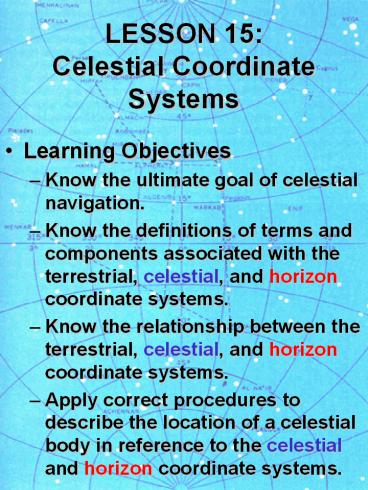LESSON 15: Celestial Coordinate Systems - PowerPoint PPT Presentation
Title:
LESSON 15: Celestial Coordinate Systems
Description:
Hour Circle of Aries. Declination. celestial equivalent of latitude. Hour Angles ... GHA = GHA(Aries) SHA. 3. Horizon Coordinate System ... – PowerPoint PPT presentation
Number of Views:1393
Avg rating:3.0/5.0
Title: LESSON 15: Celestial Coordinate Systems
1
LESSON 15Celestial Coordinate Systems
- Learning Objectives
- Know the ultimate goal of celestial navigation.
- Know the definitions of terms and components
associated with the terrestrial, celestial, and
horizon coordinate systems. - Know the relationship between the terrestrial,
celestial, and horizon coordinate systems. - Apply correct procedures to describe the location
of a celestial body in reference to the celestial
and horizon coordinate systems.
2
The Goal of Celestial Navigation
- The solution of spherical triangles of sides
based on the observed positions of celestial
bodies, in order to determine the position of a
vessel. - 100 years ago, this involved some complicated
spherical trigonometry. - Today, it requires the use of tables or a
navigational calculator (HP makes one).
3
1. Terrestrial Coordinate System
- A quick review
4
Basic Assumptions
- First, assume the earth does not move, but
instead the celestial bodies rotate about it in a
predictable manner. - The celestial sphere celestial bodies are
assumed to be on the inner surface of a vast,
hollow sphere of infinite radius, which has the
earth at its center.
5
2. Celestial Coordinate System
- The celestial coordinate system is best
understood as a projection of the terrestrial
coordinate system, outward into space onto the
celestial sphere.
6
Declination
7
Celestial Coordinate System
- Celestial Equator (Equinoctial)
- Celestial Meridians
- Hour Circles
- Hour Circle of Aries
- Declination
- celestial equivalent of latitude
- Hour Angles
- celestial equivalent of longitude
8
Hour Angles
- Three different references are used
- Sidereal Hour Angle (SHA)
- Hour Circle of a celestial body, as referenced
from the hour circle of Aries (measured westerly) - Greenwich Hour Angle (GHA)
- Hour circle of a celestial body, as measured
relative to Greenwich Celestial Meridian - Local Hour Angle (LHA)
- Hour circle of a celestial body, as measured
relative to the local celestial meridian
9
Hour Angles
GHA GHA(Aries) SHA
10
3. Horizon Coordinate System
- In the terrestrial and celestial coordinate
systems, the basic references are the poles and
the equator. - The horizon coordinate system, however, is based
on the observers position. - This system is necessary because stars are
sighted with respect to the observers position.
11
Horizon Coordinate System
- Zenith and Nadir
- analogous to north and south poles
- Vertical Circle
- analogous to meridian (terrestrial system) or
hour circle (celestial system) - Prime Vertical (east and west)
- Principal Vertical (north and south)
12
Horizon Coordinate System
13
Horizon Coordinate System
- Celestial Horizon
- analogous to the equator
- True Azimuth (Zn)
- analogous to longitude
- Altitude
- analogous to latitude
- Sextant Altitude (hs)
- Measured altitudes of celestial bodies
- Visible or Sea Horizon
- Used as a reference for celestial body altitude
measurements - Observed Altitude (Ho)
- Conversion of Sextant Altitude, since sea horizon
is not at celestial horizon.
14
The Celestial Triangle
- These three coordinate systems (TERRESTRIAL,
CELESTIAL, AND HORIZON) are then combined to form
the celestial triangle, which is used to
determine our position. - One leg from each triangle forms the new triangle
on the celestial sphere.
15
The Celestial Triangle
16
The Celestial Triangle
- Azimuth Angle (Z)
- Meridian angle (t)
17
Coordinate System Comparison































